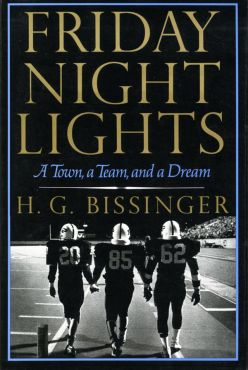Chapter Six of Nakkula’s book, Understanding Youth, goes along well
with the book I’m teaching in my sports lit class: Friday Night Lights.
The book is about Odessa, Texas, a football-obsessed town that values sports before academics. The story
follows the trials and tribulations of the Permian Panthers, the town’s most
popular high school football team. Their games are the most important
events in town. They are looked
upon with a disturbing religious fervor.
The players are treated as both royalty and celebrity, and the gender roles
that they grow up in are consistent with the information found in Chapter 6 of
Nakkula’s book.

On p. 100 of Understanding Youth,
Nakkula writes “[a]s contemporary research has made clear, biology and
environment (or nature and nurture) continually interact to inform virtually
every aspect of human social functioning.” This has clearly been true in my experience in teaching. Environment and genetics always play a
role in students’ personalities.
This is also true in Friday Night Lights. There are many “gendered norms” picked
up by the students of Permian High School that are hard to break out of,
especially because, as Nakkula adds, there complex gender scripts that have
been established in their lives (100).
Football is considered the ultimate masculine activity at their town and
school. On the other side, the
normative feminine activity is inclusion in the “Pepettes” a group of
exclusive girls who are personal assistants to the football players throughout
the season. They deliver baked
goods to their assigned player on game day, decorate their lockers, and create
elaborate celebratory signs that are then placed on the players’ front
lawn. The manly football players
are taken care of by their accommodating female assistants. Few people question these obviously
unfair gender norms and, as Nakkula adds, “ [i]n essence, the players are lost
to the play itself” (100).
The Pepettes
What happens to the young women
affected by these unfair circumstances?
Nakkula mentions studies done by Carol Gilligan that have found that
adolescent girls are forced to conform to established culture norms. Gilligan calls this “going
underground,” a process that forces young women to hide their true personality
for fear of losing their relationships (103). This commonly can lead to a disconnection with self. I imagine this would pull someone’s
identity into disequilibrium.
Since there are few moratoriums offered in school to help pull the self
back into equilibrium, girls end up sacrificing their authentic self for social
acceptance (107).
"Going Underground" by The Jam
Nakkula write about a need for a
“home place” – a safe haven girls congregate to have “safe exchanges of ideas,
intimate discussions of desire, and expressions of anger and frustration felt
in response to the external world” (107).
These ideas can be applied to Friday Night Lights. There doesn’t seem to be any home places for the women to discuss their thoughts on the unfair societal rules. Very few girls are in advanced level
classes and even less in science and math courses. Their SAT scores are much lower than the statewide average
and much lower compared to the boys’ scores. The townspeople expect them to be dumb and to serve the
almighty football team.
There is an interview in the book
with a high-achieving female student who acknowledges the gender disparities in academics and sports at
Permian High School. She sometimes
wishes she could dumb herself down in order to be part of the Pepettes, but realizes that’s not her. She is one of the rare students at the school who hasn’t
“gone underground.”
Nakkula writes about the frequent
home places constructed for boys that breed homophobia. These are the places that “socialize
boys into masculine stereotypes of toughness and independence, thereby
discouraging sensitivity and intimate caring” (111). This parallel to Friday
Night Lights is an obvious one: the football locker room is the ultimate
home space for teenage boys and the emphasis put on masculinity is
bewildering. Nakkula writes that
these situations “reinforced a sense of isolationism among many boys and men,
thereby reducing their opportunities for mutually beneficial growth” (111). No wonder so many middle-aged men never
grow out of the teenage football years: they were never allowed to grow in a
socially healthy environment.
Nakkula goes on to write about how
these ideas of masculinity negatively affects thoughts on homo-sexuality in
youth. Gay boys are frequently
faced to hide in closet (114).
They must hold back from being their true selves, using energy to hide
from others that they are different.
This reminds me of Maslow’s Hierarchy of Needs. If the second tier of the pyramid, the
feeling of safety, falls out the bottom of a student’s identity, the results
cannot be good.
This last part of the chapter
reminds me of Jason Collins, the first athlete in a major sport to come out of the closet. Collins had been in the
closet for most of his career. He
even became engaged a woman, only to break it off after he realized deep down,
what he knew about his true self.
Perhaps Collins would’ve been able to avoid this heartache is society
was more responsive to homosexuality, especially in sports.
However, Collins’ bravery does hopefully help others deal with their own
sexuality. Unfortunately, Collins hasn't been signed to an NBA team yet this season. Hopefully, this will change soon!

Actually, Collins is known for his good defense and his lack of offensive skills. Bu still, he def doesn't fit into the normative ideology at all!
ReplyDeleteCorey, have the cheerleaders in the book actually gone underground? Is making the decision to go underground always a conscious one?
ReplyDelete